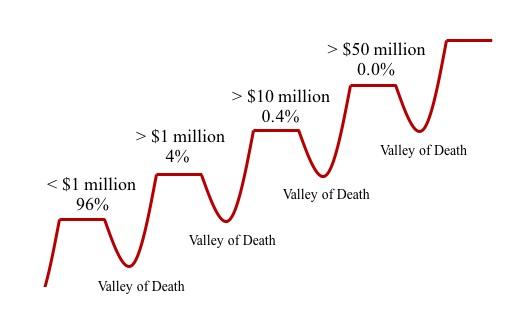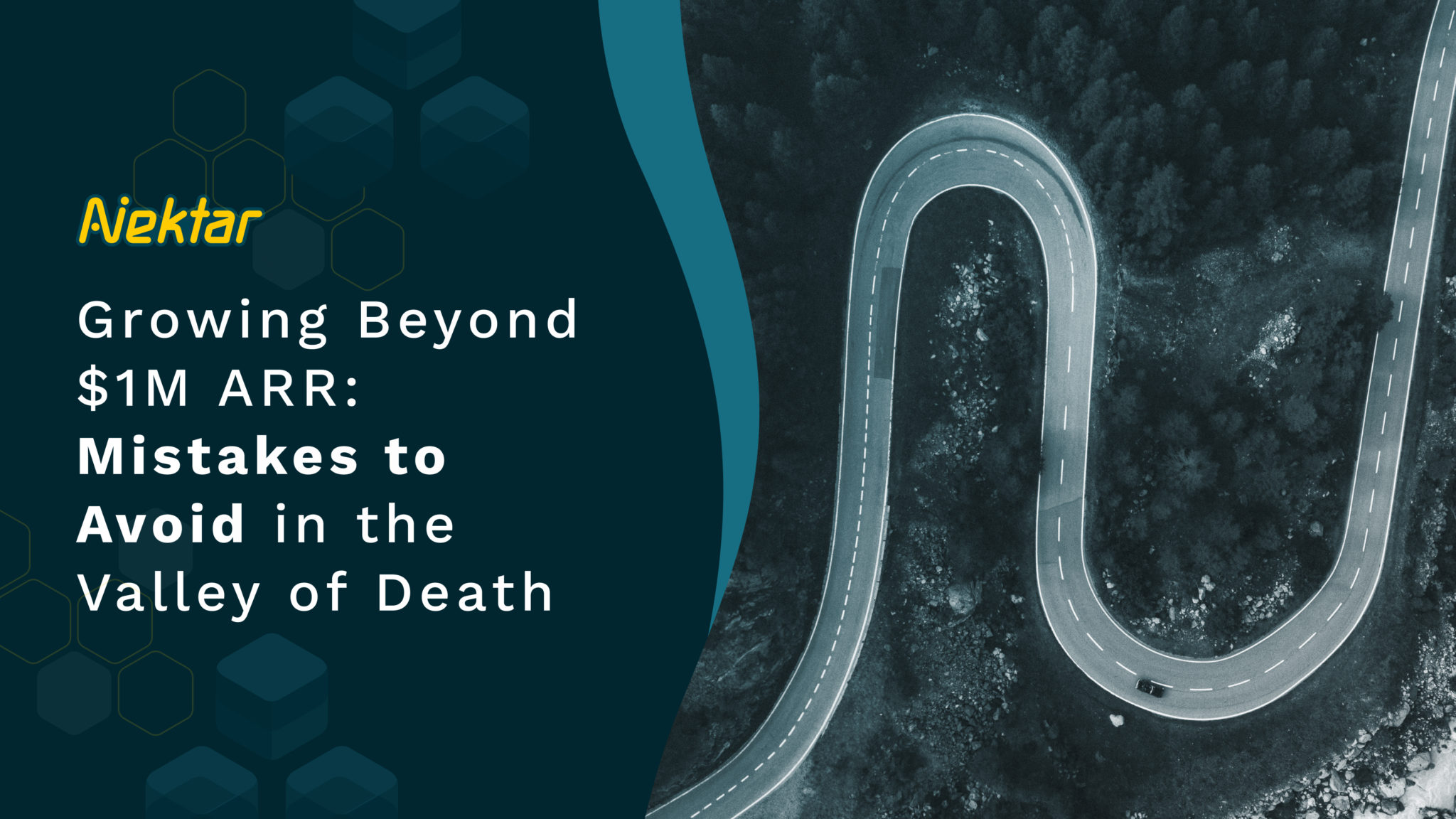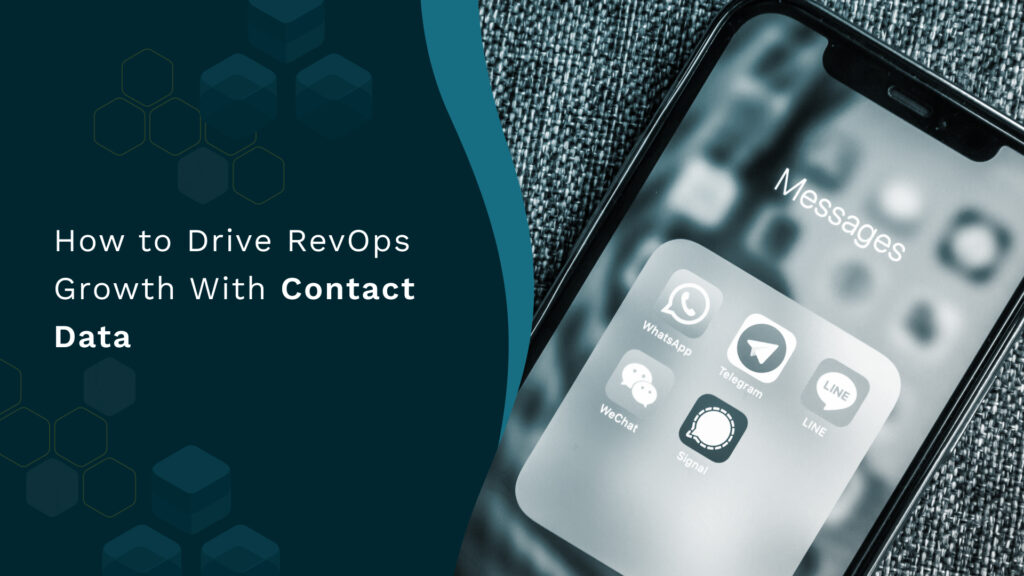If you are a SaaS business that has crossed the $1m ARR mark, congratulations! You belong to a group of <1% of businesses that manage to reach this number. A bigger challenge lies ahead in the form of the valley of death.
Only 4% of SaaS companies reach $1 million in revenue, and only 0.4% make it to $10 million. This is the Valley of Death that has eliminated countless businesses.
Scaling to $10 million ARR and beyond is where a lot of promising startups dissolve. As revenue numbers increase, that number shrinks even more.

What is the Valley of Death?
The valley of death is that period in the life of a start-up where it has begun operations, but hasn’t started generating revenue. From a start-up receiving its initial capital contribution until it finally starts to generate revenue is what this period covers.
The valley of death is a challenging period for start-ups. This period marks a heightened risk of failure. The longer the time spent in the valley of death, the higher the chances of the company fizzling out.
Surviving this death valley is considered a significant milestone for a start-up. It signals better chances of the company reaching maturity.
Carving the Journey from $0-$50 Million
According to Abhijeet Vijayvergiya, CEO at Nektar.ai, all start-ups go through similar challenges and they have to navigate through them. The challenges a startup will face at $0-$1m journey will be very different from the challenges at $10-$25m, or $25-$50m.
Each stage requires a different approach. Let’s deep dive.
1. Getting to $1 million – Find your Product Market Fit
In the 0-1 journey, focusing on the core mission of why a startup was formulated is key. This is the stage where founders try to validate their product’s value proposition. They answer questions like:
- Is there a market for my product?
- Is there a product fit to that market?
Focus is key in this stage. Trying to do a bunch of different things and picking up on what works can be a recipe for disaster. $0-1m is more about taking calibrated steps that help a founder validate their value proposition.
A lot of startups fail to go beyond this stage is because of a lack of focus.
It’s very easy to get distracted. I think a lot of startups die because they lose focus and they get distracted from their core mission. This does not mean that you can’t pivot. You definitely should pivot when you evolve as a company, you achieve product market fit or you see traction. But at the same time, you should not be doing too many things. That’s a very common mistake I have seen that a lot of start-ups make. Figure out what you’re solving for. Every start-up starts with a vision. You have a problem that you feel is unsolved and something that you can uniquely solve in a way nobody is solving it today. And you can do it X times better in case it’s already sold by somebody.
Abhijeet Vijayvergiya
Trying to force growth is what makes several startups fail to go beyond this stage. Abhijeet says that an initial team member will always see whether there is a product market fit or not. He advises founders to not force the scale of motion till the time they hit that product market fit.
In the 0-1 million journey, it’s important for any startup to stay focused, get to that product market fit, iterate fast, evolve to solve the problem that was intended for, and do all of it in a way that there is a commercial value attached to it.
2. $1m – $10m – Double Down on what Has Worked
This is where the valley of death begins. A stage where you are with a million dollars in revenue with a core value proposition that is validated. But you have this looming danger of scaling to $10 million, where a very minuscule number of startups are able to successfully achieve. So how do you do that?
According to Abhijeet, if a startup has achieved product market fit, they will be in a great position to start scaling.
He warns against startups starting to open new markets, launch new products, or start talking to different sectors of customers, all in a haste to reach 10 million ARR. What’s important is to constantly look at the problem that the company has solved and how they have solved it. Learn from that and templatize all those learnings into a playbook.
Do more of what has worked for you. Just doing this makes the $1-$10m journey quite easy. In my past experience, we figured out how the founders sold to the first 5, 10, 20 and 50 people. We could really onboard sales teams in a way that they started delivering their first deal within the first 6 months of joining in a new market.
Abhijeet Vijayvergiya
Abhijeet also emphasizes on the importance of customer retention while talking of his experience at Capillary Technologies. He says, “We did a great job at retaining our customers. We still have the lowest churn rate in the industry. We’ve always focused on delivering that delight to our users and customers so that they become our evangelists.”
Surviving the valley of death requires founders to understand the pain their company is solving for. They need to be really looking at why the company or the product exists in the first place.

Founders also need to find a way to covert the tribal knowledge floating in their minds into a working playbook that can be executed.
“The first and foremost thing that you should do once you hit a product market fit & you’re looking to scale and ramp up is to articulate that knowledge that is in your head into a playbook and templatize it. That gives you a solid foundation and a scalable model,” advises Abhijeet.
3. The Journey from $10m to $50m
After $10m is when most startups start to hit some ceilings in certain markets. Innovation plays a key role in surviving this journey.
“You need to continuously innovate, whether it’s creating new products, going for price upgrades, or adding more value to what you’re currently offering,” says Abhijeet.
Between $10-$50m, a lot of strategy and product comes into play. This is the stage where it’s most important to keep fuelling the growth. Another crucial goal highlighted by Abhijeet is for founders to constantly look at their sales capacity in the addressable market.
We would always go into that exercise of what’s our addressable market – how many logos are out there, have we spoken to all of them? And if not, how soon can we speak to them? Because they all have similar problems, they need us, we need to be out there in those meeting rooms where they are thinking about solving those problems.
Abhijeet Vijayvergiya
Investing in sales enablement also becomes crucial at this stage in order to help the new set of sales hires to operate at similar thresholds as the founding team.
Abhijeet also advises to hire VP’s for all functions around this time. But it’s important to hire right.
What I have also seen people do wrong is not doing endgame in the core markets where they are seeing success. They will open in more and more markets, and that will mean you’re spreading thin. At the same time you are leaving money on the table in the existing markets which you are really good at. It’s very important to go for market share between $10m-$50m. Which are your core markets? If you’re doing quite well then go for market share. And when you’re opening new markets, you’re opening them strategically and as soon as you hit a million dollars in a new market, you double down and get to 10m after that.
Abhijeet Vijayvergiya
How to Cross Over the Valley of Death
There can be a number of reasons that make surviving the Valley of Death almost impossible for so many businesses.
Let’s explore 3 of the most common pitfalls that lead to start-ups getting crushed by the Valley of Death.
Let’s take a look.
1. Trying to do too many things
Every growth stage has its own unique requirements. What worked before reaching a million dollars in revenue will not work when aiming for $10 million and beyond.
Going beyond the $1 million mark can be exciting. And founders might put too much pressure on themselves and their teams to don multiple hats.
This is also the time when a base team is already built. This team brings brilliant ideas to the table that promise growth.
However, trying to focus on too many things is where things start to go wrong. Scaling beyond this point requires laser-focus on achieving the north-star that the business decides for itself.
To achieve set business goals, it is crucial to establish processes that keeps companies on track. Founders and sales leaders should be able to focus on the best idea and create a process around achieving it.
As a sales leader, you are an important part of the organization. You must create a conversation around - What creates the most impact with the least effort?
To do this effectively, create that playbook on the sales process that can help build a robust GTM machine.
Instead of making mental calculations on aspects of scaling such as hiring and revenues, the process of translating the product and sales knowledge of founders into standardized policies for everyone in the organisation is a must.
Without a process set in place, founders end up doing too much, or focusing on things that have no long term impact.
Spreading too thin at this stage with too many things can result in a lot of churn or businesses can end up focusing on the wrong efforts.
At this stage, businesses should be able to create a scalable and repeatable playbook engine that keeps them on the right track. Founders need to look at their businesses critically and really try to understand their key strengths and weaknesses.
2. Failing to evolve the sales process
The initial “honeymoon” period from $1-5M ARR is where things are working smoothly at a micro level. A small and efficient sales team is following a founder-led sales process and getting personally coached since Day 1. There might be a fair amount of inbound based on personal networks too. Things are mostly peachy.
However, things start going downhill as this revenue goal increases beyond $5M in ARR. Companies need to change their approach as they move upstream.
The processes that led to success before reaching the million mark will not work anymore. The initial use cases might start to show limitations or the product might start to hit failures.
A strong strategy is extremely crucial to navigate this scaling process. Founders need to do the same level of 0-1 product market fit journey they did when they started the company.
There needs to be investment in scale; the sales process should be scalable and extendable. The right tech stack will play a crucial role in achieving this.
On the GTM side, founders need to start training their team. Sales cycles are entirely different, for example, when you move from SMB to enterprise.
A lot of nuances come into play as companies scale and they need to be accounted for.
Navigating the dynamics of the buying organization and getting visibility into the buying committee is crucial to be truly scale-ready.
Companies that go beyond this threshold have a hyper-optimized sales and marketing engine that is repeatable and predictable.
3. Hiring without intent
The main reason why SaaS companies stall out at $15m ARR is because they don’t measure customer happiness as a core metric.
Building a solution that customers love requires an implementation plan that can help scale the product. Every company needs a stellar team that can help in constant product development, and support the product and implementation pipelines.
While operating in the wildly unpredictable world of SaaS startups, one hiring decision can literally make or break a business.
The average cost of a bad hire is up to 30% of the employee’s first-year earnings. For a SaaS startup that has just started incurring operational costs, this number can be huge.
One mistake that startups make is that they hire professionals from the biggest brands who are probably operating at a $100m or billion dollar scale. That is very different from how a $10m or $5m company will operate. There is a lot to learn from professionals from bigger enterprises who are operating at a bigger scale. But I think at the stage around the $10m mark, you can’t use the things they are using. You need to still hustle, you need to still roll up your sleeves. Your sales head needs to train your sales reps as well as go in the field to close some of the larger deals. Be a coach and figure out predictable growth at the same time.
Abhijeet Vijayvergiya
Poor hires can result in lost productivity and expenses in hiring, recruiting and training replacements. According to CareerBuilder, almost three-quarters of companies who made a bad hire reported an average of $14,900 in wasted money. With 74% of employers stating they hired the wrong person for the job.
Trying to scale too fast without paying attention to hiring needs can create bottlenecks to growth. Failing to distinguish the best candidates from the “average” ones can cost companies heavily.
It is important to invest in building a brand and expanding recruitment capabilities in the valley of death. But the intention needs to be set right. Anything haphazard or unplanned can end up diluting a business.
For example, hiring a VP of Sales at the right stage will help founders manage sales efficiency through the valley of death. The right hire can help scale the sales team and build a predictable sales engine. But rushing the hiring process and making the wrong hire can set the business back in time.
Scaling through the valley of death is certainly not going to be easy. It’s a road travelled by very few SaaS businesses. Analyzing every growth cycle and understanding its challenges and opportunities is what can help startups navigate the valley of death.
Have anything to add to this? Let us know in the comments section or share your thoughts with us at [email protected]







